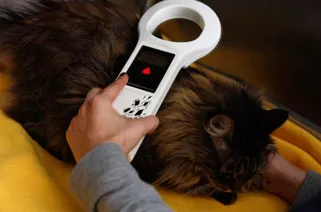Every year, thousands of dogs and cats go missing, leaving heartbroken owners searching desperately for their furry companions. Statistics from pet recovery organizations show that only about 20-30% of lost pets are reunited with their families, often due to inadequate identification. While collars and tags are common, they can break, fade, or be removed, putting your pet at risk. That’s where pet microchipping comes in—a reliable, permanent solution that dramatically boosts the chances of a safe return. If you’re a dog or cat owner in Vietnam or anywhere else, understanding microchipping can protect your beloved pet from becoming one of those heartbreaking statistics.
What is a Pet Microchip?
A pet microchip is a tiny electronic device, roughly the size of a grain of rice, designed for subcutaneous implantation. It’s typically placed between your pet’s shoulder blades under the skin, a quick procedure that takes just a few minutes and requires no surgery. Each microchip contains a unique identification number linked to your contact details in a national or international pet recovery database.
Veterinarians use a simple injection to insert the chip, often during a routine check-up or vaccination visit. Once implanted, it’s tamper-proof and lasts the pet’s lifetime without needing batteries or maintenance. For cat owners, this is especially crucial since indoor cats can slip out unnoticed, while dogs on walks might escape leashes. According to the American Veterinary Medical Association (AVMA), microchipping increases reunion rates by up to 75% in shelters equipped with scanners.
 Veterinarian scanning a cat's microchip with a handheld reader
Veterinarian scanning a cat's microchip with a handheld reader
The Microchipping Process Step-by-Step
The process is straightforward and minimally invasive, making it suitable for pets of all ages. Here’s how it works:
Consultation and Registration: Your vet discusses your pet’s health and provides a registration form. You’ll enter your name, address, phone, and email into a database like PetLink or HomeAgain, which are accessible globally.
Implantation: Using a sterile needle, the vet injects the chip. Your pet might feel a brief pinch, similar to a vaccine, but most don’t need sedation.
Scanning and Verification: Immediately after, the vet scans to confirm the chip’s readability and registers the number.
If your lost dog or cat ends up at a shelter, animal control, or clinic—common in urban areas like Hanoi or Ho Chi Minh City—a universal scanner detects the chip in seconds. The unique ID leads to a database lookup, notifying you via a toll-free call. Good Samaritans or finders can take the pet to any equipped facility, ensuring quick reunions.
Real-life example: A Hanoi cat owner shared on a local pet forum how their escaped tabby was scanned at a shelter two days later, leading to a joyful reunion thanks to the microchip—something a collar alone couldn’t guarantee.
Benefits of Microchipping Dogs and Cats
Beyond reliability, microchipping pets offers unmatched advantages:
Permanent ID: Unlike collars that snag on fences or tags that fade in Vietnam’s humid climate, chips stay put.
Nationwide and Global Reach: Databases connect with international networks, ideal for traveling pet owners.
Proven Effectiveness: Studies from the ASPCA indicate microchipped pets are four times more likely to return home.
Affordable Protection: Costs range from $20-50 USD (about 500,000-1,200,000 VND), a small price for peace of mind.
Even breeds prone to wandering, like energetic Golden Retrievers or curious Siamese cats, benefit immensely. Indoor pets aren’t immune—doors left ajar or balcony escapes happen daily.
Is Microchipping Safe for Puppies, Kittens, and Adult Pets?
Absolutely. Puppies and kittens can be microchipped as early as 8 weeks, aligning with their first vet visits. Adult pets, even seniors, tolerate it well with no anesthesia required. Side effects are rare; minor swelling resolves in hours. The AVMA and World Small Animal Veterinary Association (WSAVA) endorse it as safe, with millions implanted worldwide annually.
For Vietnamese pet parents, local vets at clinics like Thú Y PetCare or Animal Hospital in major cities offer this service routinely. Always verify the chip’s ISO standard (11784/11785) for universal scanner compatibility.
Why Even Indoor Pets Need Microchipping
Many owners assume indoor dogs and cats are safe, but accidents occur—a screen door tears, a window cracks, or curiosity wins during moving day. Without backup ID, recovery odds plummet. Microchipping bridges that gap, providing invisible insurance.
Final Thoughts on Pet Microchipping
In summary, pet microchipping is a simple, safe, and effective safeguard against the devastation of a lost companion. From implantation to database registration, it empowers vets, shelters, and finders to reunite you swiftly. Don’t wait for an emergency—proactive owners microchip early.
Consult your veterinarian today about microchipping your dog or cat. For more tips on pet care, explore our guides on vaccinations and nutrition. Your pet’s safety starts with you!
References
- American Veterinary Medical Association (AVMA): avma.org/resources-tools/pet-owners/petcare/microchipping-your-pet
- ASPCA Lost Pet Statistics: aspca.org
- WSAVA Guidelines on Microchipping: wsava.org
